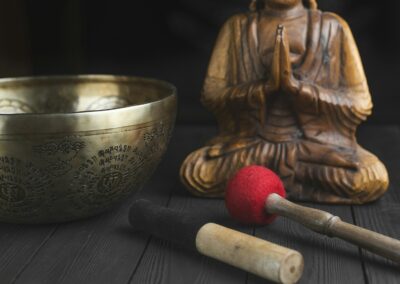Equine health and wellness is complex and challenging, with traditional veterinary medicine often reaching its limits. For countless horse-related diseases and problems that seem merely ‘manageable’ or are dismissed as ‘training issues,’ a new therapeutic approach has emerged – Tucker Biokinetic Therapy (TBT).
Developed by Dr. Renee Tucker, an equine veterinarian with a wealth of experience and a Bioengineering degree to boot, TBT offers a breakthrough solution. This therapy melds the principles of biomechanics and energy work to provide a gentle yet effective treatment method, focusing on realigning the horse’s body and resetting its internal mechanisms.
With an array of applications, TBT addresses conditions including Navicular, Arthritis, Suspensory Injury, Chronic Colic, Fly Allergies, Phantom Lameness, and many more. It also effectively tackles behavioral and performance-related issues like stiffness, one-direction preference, bucking, and counter-cantering.
This article will journey into the details of Tucker Biokinetic Therapy, exploring how it works, its uses, and some of the notable brands applying this therapy. Additionally, we will discuss when to avoid TBT and provide resources for further learning. By the end of this piece, you’ll be equipped with a wealth of knowledge to decide whether Tucker Biokinetic Therapy is right for your horse. Let’s delve into the revolutionary world of Tucker Biokinetic Therapy, unlocking the potential for comprehensive equine health and wellness.
Understanding Tucker Biokinetic Therapy: Bridging the Gap in Equine Healthcare

The journey to understanding Tucker Biokinetic Therapy (TBT) begins with its creator, Dr. Renee Tucker. As an experienced equine veterinarian, Dr. Tucker realized that traditional medicine often failed to address many horse health issues effectively. Driven by her passion for equine wellbeing, she developed TBT, leveraging her veterinary medicine and bioengineering expertise.
TBT falls under the broader category of energy work but has a unique twist: it doesn’t draw from the practitioner’s energy but modulates the horse’s energetical motilities. In essence, it works in harmony with the horse’s innate bodily mechanisms, taking a bio-kinetic approach to therapy that uses minimal physical force and yet brings about profound results. It’s a technique that requires a strong mental focus but is gentle on both the practitioner and the horse, making it an accessible therapy for many.
The TBT process involves a few critical steps:
- Body Checkups: The practitioner first determines what the horse’s body can and cannot do through thorough TBT Body Checkups. This initial evaluation explains the horse’s physical condition and potential challenges.
- Primary Cause Analysis: Following the body checkup, the practitioner identifies the underlying cause of the horse’s issues. This root-cause approach ensures that the treatment targets the real problem rather than just alleviating symptoms.
- TBT Alignment: Once the root cause is identified, TBT realigns the horse’s body. This alignment process not only corrects structural imbalances but also resets internal mechanisms back to normal. It negates the issue of muscle memory, which is a common roadblock in many traditional therapies.
Through this three-pronged approach, TBT creates a thorough, holistic, and solution-oriented treatment plan for horses. Whether your horse is facing physical ailments or performance-related problems, understanding Tucker Biokinetic Therapy might just be the key to unlocking its optimal health and well-being.
The Mechanisms of Tucker Biokinetic Therapy: A Two-Handed Approach to Equine Healing

At the core of Tucker Biokinetic Therapy (TBT) lies a distinct two-handed technique, a method that employs minimal physical force but requires a strong mental focus from the practitioner. Understanding the workings of TBT is crucial to appreciating its transformative potential in equine therapy.
To begin the therapy session, the practitioner uses a comprehensive body checkup to identify areas of tension, stiffness, or imbalance in the horse’s body. These observations serve as a starting point, allowing the practitioner to determine the current physical state of the horse and identify potential areas requiring attention.
Following the initial body checkup, the practitioner initiates the primary cause analysis. This step involves identifying the root cause behind the observed symptoms. Unlike some therapeutic approaches that focus on symptom management, TBT targets the primary cause of the horse’s issues, ensuring a more effective and long-lasting solution.
Once the primary cause is identified, the TBT alignment begins. This is where the unique two-handed technique comes into play. Each hand performs a different action simultaneously, creating a balancing effect on the horse’s body. The aim is to realign the body and reset the internal mechanisms back to their normal state, counteracting the effects of any muscle memory.
This alignment process is not forceful but rather gentle and focused. The practitioner harnesses the horse’s own energy, directing and modulating it to induce healing and balance. As such, TBT works in harmony with the horse’s natural physiological processes, promoting healing from within.
The Applications of Tucker Biokinetic Therapy
The beauty of Tucker Biokinetic Therapy (TBT) lies in its unique approach to healing and its wide-ranging applicability. As an energy-focused, non-invasive technique, TBT has proven beneficial in treating various equine conditions, ranging from physical ailments to behavioral issues.
One of TBT’s primary applications is in addressing common physical diseases in horses. These include Navicular disease, arthritis, and suspensory injuries, conditions that are often tough to manage with traditional equine medicine. Chronic ailments such as colic and fly allergies can also be effectively addressed through TBT. Phantom lameness, a condition characterized by intermittent unexplained lameness, is another area where TBT has shown promising results. Additionally, issues related to back soreness, typically a result of muscular tension or skeletal misalignment, can be effectively treated with TBT’s realigning techniques.
Moreover, TBT has a substantial impact on horses suffering from reproductive issues. Particularly in mares, conditions causing discomfort or distress can be effectively alleviated through TBT, leading to improved health and reproductive success.
On the behavioral front, TBT offers an effective solution to problems that are often misattributed as training issues. Unwanted behaviors such as bucking, rushing courses, counter-cantering, and rearing can all be addressed through TBT’s body realigning and energy-balancing techniques. Furthermore, horses exhibiting stiffness, unwillingness to bend, or a preference for one direction can benefit from the therapy, leading to improved performance and comfort.
TBT’s applications also extend to improving overall performance and well-being. By aligning the horse’s body and resetting its internal mechanisms, TBT contributes to increased flexibility, enhanced movement, and overall improved physical performance. These improvements, coupled with the potential reduction in stress and discomfort, contribute to a happier, healthier horse.
Recognized Brands Incorporating Tucker Biokinetic Therapy
While Tucker Biokinetic Therapy (TBT) was created by Dr. Renee Tucker, the therapy’s immense potential for enhancing equine well-being has encouraged its adoption by several recognized brands and practitioners in the field. These entities, driven by their commitment to advancing equine health, have incorporated TBT into their repertoire, contributing to its growing recognition and acceptance.
- Where Does My Horse Hurt: This platform, established by Dr. Tucker herself, is at the forefront of disseminating information about TBT. Through this online resource, Dr. Tucker shares solutions to various puzzling horse problems, with TBT playing a central role.
- Tucker BioKinetic University: Another initiative by Dr. Tucker, this institution trains practitioners, horse owners, and anyone interested in TBT. It aims to build a community of TBT practitioners capable of truly healing horses and bringing them to optimal health.
- Touch of Hope: Operated by Angie Gaudy, Touch of Hope employs a variety of techniques to help horses, including TBT. Angie’s comprehensive approach illustrates how TBT can be combined with other modalities for an all-inclusive equine treatment plan.
- Journey to the Heart: This organization uses TBT as part of its efforts to help rescue horses recover from past trauma and injury. TBT forms a key part of their healing and rehabilitation program.
As TBT continues to prove its efficacy, more and more organizations, and practitioners are likely to embrace it. This broadening scope will undoubtedly propel the growth and development of Tucker Biokinetic Therapy, further solidifying its place in equine healthcare.
Tucker Biokinetic Therapy: When to Use Caution
While Tucker Biokinetic Therapy (TBT) is known for its wide applicability and non-invasive nature, like any therapeutic approach, it’s crucial to understand when caution is necessary. Recognizing potential risks and contraindications helps ensure TBT’s safe and effective use.
Firstly, TBT should be practiced only by trained practitioners or under their guidance. Despite its seemingly simple technique, TBT requires a deep understanding of equine anatomy, physiology, and energy dynamics. Attempting to practice TBT without proper training can potentially lead to incorrect application and, in the worst cases, can cause harm to the horse.
Secondly, while TBT is generally safe for most horses, specific cases may not be recommended. Horses with severe acute conditions or those undergoing certain medical treatments might not be suitable candidates for TBT. It’s always important to consult with a veterinarian or a trained TBT practitioner to ensure the therapy is safe for the horse in question.
It’s also important to note that while TBT can address a multitude of physical and behavioral issues, it is not a replacement for veterinary medicine. A qualified equine veterinarian should always examine severe or persistent problems. TBT should be seen as a complement to traditional veterinary care, not a substitute.
Lastly, one should keep in mind that the success of TBT, like any therapy, cannot be guaranteed for every horse or every condition. While TBT has been successful in addressing a wide variety of issues, some horses might respond better to other therapies or a combination of treatments.
Making the Right Decision for Your Equine Partner
Before deciding to incorporate Tucker Biokinetic Therapy (TBT) into your horse’s care routine, it is important to assess your horse’s individual needs and personal goals and capabilities. This evaluation process can help ensure that TBT is suitable for you and your equine partner. Here are some guiding questions to help facilitate this assessment:
- What are the primary health issues my horse is facing? Understanding the specific problems your horse is dealing with can help you evaluate whether TBT’s applications align with your horse’s needs.
- How have traditional veterinary methods worked so far? If your horse’s issues persist despite traditional veterinary interventions, TBT may offer a complementary or alternative approach.
- Is my horse showing any behavioral issues that could be related to physical discomfort or imbalance? TBT is known to help with a range of behavioral problems stemming from physical causes.
- Am I open to energy-based therapies? TBT falls under the umbrella of energy work. Being open to such an approach is crucial for a successful TBT experience.
- Am I willing to learn a new technique or work with a trained TBT practitioner? TBT requires specific techniques that one must learn from a trained professional or become a trained professional to apply correctly.
- Does my horse generally respond well to touch and hands-on therapies? TBT involves hands-on techniques, so it’s important that your horse is comfortable with this type of interaction.
- What are my long-term goals for my horse’s health and well-being? Considering your long-term objectives can help determine if TBT’s holistic approach aligns with your goals.
Remember, every horse is unique, and there’s no one-size-fits-all solution in equine healthcare. Your horse’s comfort, well-being, and overall health should always be at the forefront of any decision-making process. These self-evaluation questions should aid in the process of deciding whether Tucker Biokinetic Therapy is the right path for your equine partner.
References and Additional Resources
Books:
“Where Does My Horse Hurt?” by Dr. Renee Tucker: This book provides in-depth insights into horse ailments, their causes, and how TBT can help address them. It’s a must-read for anyone interested in the therapeutic potential of TBT. The book can be found here.
Websites:
Tucker BioKinetic website https://www.tuckerbiokinetic.com/: This is the official platform for TBT training. It provides detailed information about becoming a TBT practitioner and how the technique can be effectively utilized.







